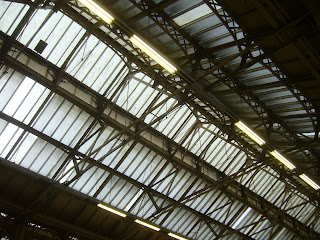












London, England
Population of Metro Area: 13,945,000Population of City Proper:7,556,900Year Founded: 43
London is obviously one of those cities I have dreamed of going for a very long time and remarkably, it did not dissapoint. For a person like myself who loves older architecture, particuraly 18th and 19th centuary, there is certainly plenty of it. While the central city is in many ways smaller than I expected, the city is built to a scale I haven't seen since Tokyo and as such I was able to visit mostly only the touristy parts of town. Unfortunately this means I have little useful information on how the city actually functions in terms of day to day city life.
I will say this though, the Underground system works amazingly, the city is very walkable and pedestrian friendly, and the street scapes are absolutely beautiful. The city is also cheaper than I expected. Especially coming from Dublin and considering the pound is stronger than the Euro, I was surprised to find that you can still get a double cheeseburger for around $1.50 USD and a beer in a pub runs about $4.50 USD. I was a little surprised to find all of the romanticised red telephone boxes plastered with numbers and photos of escort services and late night talk lines, but I guess everything is not to be as expected.
London is now the third place in a row I have visited the uses only double decker buses, and I will say that they make so much more sense than the double length trailer style buses you see in the states. The view up top is amazing, and they don't clog the road any more than a regular bus but still offer double the capacity. The only downside is that all of your photo's end up with the top half of a bus in them.
What I never realized about London is that it is actually divided into the city of Westminster and the city of London. The city of Westminster is the historical and cultural heart of the city while the city of London serves as the financial and business center of the city. I think this relationship and segregation of these two cities and functions is perhaps one of the most interesting planning schemes I have seen and it solves for a sense, in London at least, the inherent conflict in how old meets new. Here the solution is clear, the old stays with the old in Westminster, and the new is allowed to come out of the old as it pleases in the city of London. I think this solution works ok in this case as the city has the space more importantly, the population for it and it has the benefit of two millennia of cultural development to uphold and preserve.
It is clear though that this idea of old vs. new is very controversial and a constant argument with in the city. This morning I read an article in the Daily Mail title "How Modernist destroyed our cities." I was surprised to see this argument in a sense, usually I'm the only one who seems to think this way, but the article covered a dispute between Richard Rodgers and the Prince of Wales. Rodgers, the award winning architect of the pompidou in Paris and the wave formed airport in Madrid, is disputing the rejection of his plans for a development on the site of the historic barracks in Chelsea. His designs were approved but upon the influence of the Prince of Wales his designs were scrapped for a more historically sensitive design. Apparently his design was approved only by the developer and the community was appalled by the historically insensitive glass and steel proposal. Rodgers called the princes interference unconstitutional and vows to fight the decision. Where the article really begins to become interesting and perhaps loose credit is in the personal bias of the writer. He spends perhaps 4 paragraphs discrediting rodgers as rich and arrogant, then going on to describe how ugly modern architecture is. My favorite description was the comparison of "glass Detroit-like towers." Haha, while clearly this person has never been to Detroit, the city still carries an awful reputation even in England. Sorry Detroit. Then, hilariously, the author goes on to discredit modern architecture as being invented by the Nazi's and communists. Clearly, everything that is said is not to be taken seriously, but some really important observations I have, were voiced very strongly by the media. That observation is that the general public prefers the texture of stone and carved ornament to the clean and sleek modernist designs. As an architect I think it's easy to get lost in design ideals and theory and forget about what the people want. As designers we see our job as to design what people don't know they want, and convince them to our agenda. But maybe were doing them a disservice, maybe they already know what they want. Of course you would argue that profession wouldn't progress and you could design out of a catalog, but maybe that's not the worst thing, or maybe it is, I'm not sure yet. What I am sure of though, and the article noted this too, is that traditional carved ornament type buildings are extremely easy to copy and reproduce. In a way this is why they work so well. It is possible to have a whole block of the same exact building, but through paint, different stones or brick,and different windows or carved ornament it is possible to make every single building look different. Modernist architecture on the other hand, while undeniably powerful when perfected, leaves little room for error, and imperfections stand out like a sore thumb. Also the style leaves little room for interpretation or variation. Stark white and concrete walls make for a very dull city scape. I guess the point that I am trying to make is that only a very small percentage of buildings can actually have the time and care allocated to them to make well designed buildings. To have a good looking city, I believe a so called "style" (I know architects hate that word) needs to be in place to allow building that look decent to be built efficiently and cheaply. So in the end of this rambling my thought for the day is traditional buildings are easy to copy and make look good, modernist buildings are very difficult to copy and often look really bad.
Sorry guys that was a tangent, but I think it's in line with the challenges of not only London, but all European Cities. London though, while there is so much I did not get to see, of what I did see, the city is truly amazing. It functions at a very high level and has the cultural destinations of first class city. I think most anyone would want to live in London, I'm just not sure too many can pay the rent.

























































